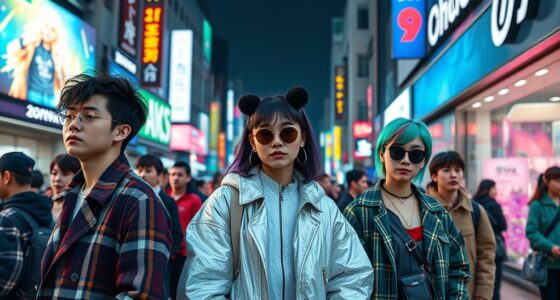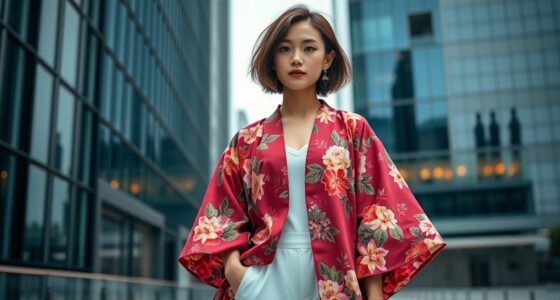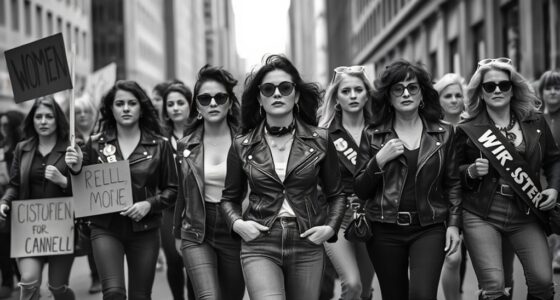Cultural icons like Frida Kahlo and Audrey Hepburn influence your fashion today by inspiring styles that blend heritage, art, and timeless elegance. Kahlo’s bold colors and traditional textiles encourage you to express cultural identity, while Hepburn’s minimalist chic promotes effortless sophistication. Their iconic looks shape contemporary designs focused on sustainability, inclusivity, and storytelling. If you stay curious, you’ll discover how these figures continue to inspire modern fashion movements and cultural expressions.
Key Takeaways
- Iconic figures like Kahlo and Hepburn inspire contemporary fashion with their distinctive styles and cultural symbols.
- Their legacy promotes sustainable and inclusive designs that celebrate diverse cultural identities.
- Traditional textiles and craftsmanship associated with these icons influence modern fashion collections.
- They serve as symbols of individuality, encouraging experimental and boundary-pushing fashion choices today.
- Their cultural storytelling through fashion enhances appreciation for heritage and ethical fashion practices.
The Enduring Impact of Frida Kahlo’s Artistic Aesthetic on Modern Fashion
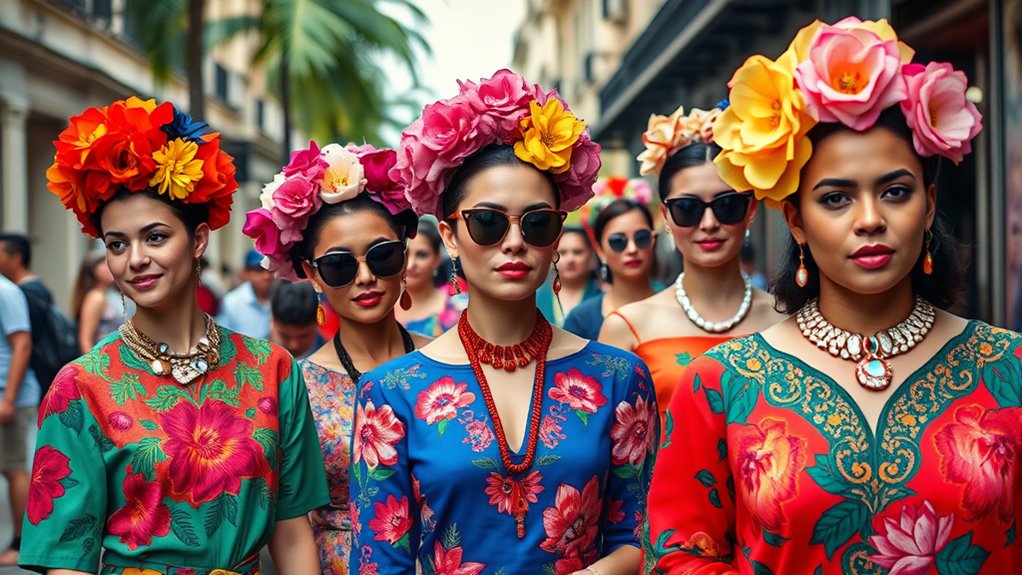
Frida Kahlo’s bold, unapologetic aesthetic continues to influence modern fashion in powerful ways. Her use of botanical motifs, like lush flowers and intricate leaves, inspires designers to incorporate natural elements into clothing and accessories. These botanical details often appear in embroidery, prints, and appliqués, creating a connection to Kahlo’s love for nature and Mexican heritage. Additionally, her vibrant color palettes, featuring bold reds, bright yellows, and deep blues, encourage new generations to embrace eye-catching hues. Kahlo’s fearless approach to self-expression encourages you to explore bold patterns and lively colors in your wardrobe. Her aesthetic reminds you that fashion can be a form of personal storytelling, blending art, culture, and nature into striking, meaningful statements. Utilizing color palettes inspired by Kahlo’s work can help you craft a distinctive and vibrant personal style. Embracing artistic influences from her paintings can further deepen your appreciation for her unique visual language. Recognizing her use of cultural symbolism highlights how her work celebrates heritage and identity, inspiring contemporary fashion choices.
Audrey Hepburn’s Legacy of Elegance and Minimalism in Contemporary Style

Audrey Hepburn’s timeless elegance continues to shape contemporary fashion, embodying the principles of minimalism and refined simplicity. Her signature style emphasizes clean lines, understated accessories, and a focus on quality over quantity. You’ll notice her influence in modern minimalist aesthetics, where less truly becomes more. Hepburn’s iconic little black dress, paired with simple pearls and ballet flats, remains a symbol of effortless sophistication. Her approach encourages you to embrace elegance through restraint, prioritizing classic pieces that stand the test of time. This legacy challenges fast fashion trends, inspiring a movement towards timeless wardrobe staples. By adopting her minimalist aesthetic, you can cultivate a style that’s both chic and versatile, echoing Hepburn’s enduring commitment to grace and simplicity.
Music Icons as Fashion Trailblazers: From David Bowie to Madonna
Music icons have long used their distinctive styles to push fashion boundaries and redefine beauty standards. Synthesizing musical influence with bold visuals, artists like David Bowie and Madonna revolutionized how we perceive style. Bowie’s androgynous personas and daring costumes challenged gender norms, inspiring designers worldwide. Madonna’s provocative looks and constant reinventions set new trends, showcasing how music icons can become fashion trailblazers. Their innovative styles often sparked collaborations with the fashion industry, leading to iconic collections and runway moments. These collaborations not only elevated their personal brands but also influenced mainstream fashion, encouraging experimental and boundary-pushing designs. Recognizing the role of music icons in fashion evolution, we see how they have transformed their music into powerful style statements that continue to inspire contemporary fashion.
The Role of Cultural Symbols in Shaping Personal Style Narratives
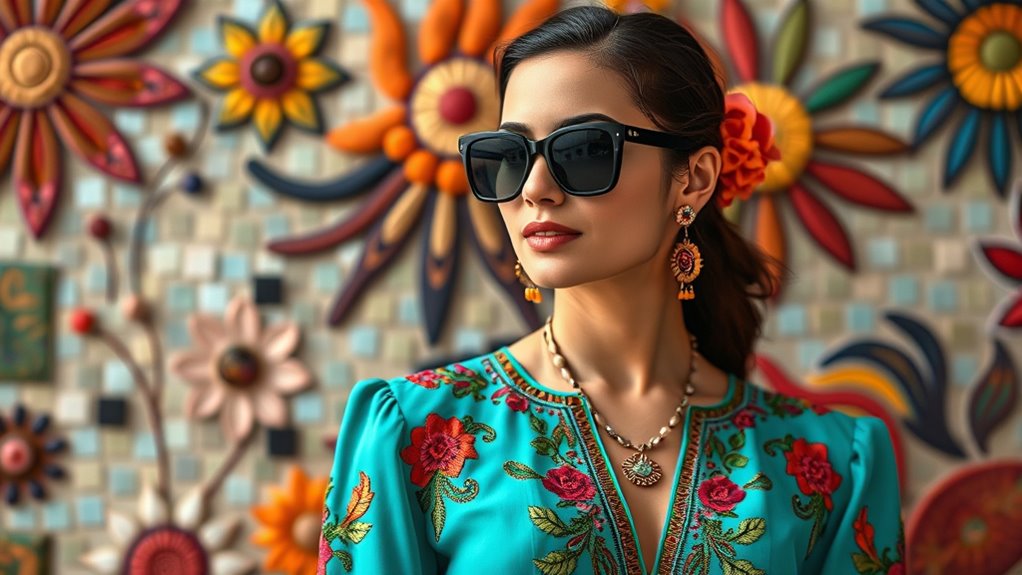
Cultural symbols serve as powerful tools that shape personal style narratives, allowing you to communicate your identity, heritage, and values through fashion. When you incorporate cultural symbolism into your wardrobe, you create a form of personal storytelling that reflects your background and beliefs. These symbols act as visual cues, connecting you to a larger cultural context and making a statement without words. By choosing specific patterns, colors, or accessories rooted in your culture, you craft a unique style that’s authentic and meaningful. Incorporating cultural motifs can deepen the connection between your clothing choices and your cultural identity, making your style even more distinctive. Understanding the visual impact of cultural symbols helps you to select meaningful pieces that resonate with your personal story. This approach transforms clothing from mere aesthetics into a narrative device, enabling you to express who you are and what you stand for. Ultimately, cultural symbolism helps you build a personal style that’s rich with history and significance.
Influencer Culture and the Revival of Classic Style Icons
Influencer culture has considerably boosted the popularity of classic style icons, making their timeless looks relevant to new generations. Today’s influencers draw inspiration from icons like Audrey Hepburn and Frida Kahlo, blending their signature styles with modern trends. This has sparked a streetwear evolution that incorporates vintage elegance and bold expressions of individuality. As influencers showcase these looks across global fashion hubs, they bridge the gap between past and present, making classic icons accessible and appealing to diverse audiences. Social media platforms amplify this effect, allowing users to adopt and reinterpret iconic styles effortlessly. By doing so, influencer culture revives and redefines timeless fashion, ensuring that these icons remain influential in shaping contemporary aesthetics. Additionally, the cultural content shared on these platforms fosters a deeper appreciation of historical styles and their significance in today’s fashion landscape. The visual storytelling prevalent on social media further enhances the connection between these iconic looks and modern fashion sensibilities, leveraging AI-powered virtual reality to create immersive experiences that bring these styles to life.
The Intersection of Art, Identity, and Fashion in Iconic Looks

Your style communicates who you are and can serve as a canvas for artistic self-expression. Iconic looks often incorporate cultural symbols that tell a story or convey a deeper meaning. By exploring these elements, you see how fashion becomes a powerful intersection of art and identity. Additionally, the influence of electric bikes and related technology demonstrates how innovation can also shape cultural expressions and personal style. Recognizing the significance of symbolic meanings in fashion highlights how clothing and accessories can embody cultural heritage and personal values. Understanding the spiritual symbolism behind certain symbols enriches the way we interpret iconic fashion choices and their cultural significance.
Artistic Self-Expression in Attire
Artistic self-expression in attire reveals how icons like Frida Kahlo and Audrey Hepburn used fashion as a powerful canvas for identity and creativity. Your personal style becomes a statement, blending art with daily life to showcase who you are. These icons demonstrate that fashion isn’t just clothing; it’s a form of art that communicates your inner world. They transformed their looks into symbols of their unique narratives, emphasizing that fashion and identity are inseparable. Their bold choices inspire you to craft a wardrobe that reflects your authentic self. Additionally, understanding divorce laws in various locations shows how personal circumstances can significantly influence lifestyle choices and self-expression. Recognizing the importance of work-life balance can also help in maintaining personal authenticity while managing professional commitments. Embracing cultural influences in fashion further highlights how personal identity and societal context intertwine in shaping iconic styles.
Cultural Symbols as Style
Fashion serves as a powerful platform for expressing cultural identity, transforming clothing into symbols that communicate deep-rooted traditions and personal stories. Cultural symbolism allows you to wear more than just fabric; it becomes a form of fashion storytelling that connects you to your heritage and history. When you incorporate specific patterns, colors, or accessories, you’re conveying messages about your background, beliefs, or social status. Iconic looks often blend art and culture, turning clothing into symbols that resonate across time and borders. This intersection of art, identity, and fashion creates a visual language that speaks volumes without words. By embracing cultural symbols as style, you not only celebrate your roots but also contribute to a global dialogue that honors diversity and shared history. Incorporating cultural motifs into fashion can deepen the expression of cultural identity and foster appreciation for diverse artistic traditions. Recognizing the influence of legendary figures like Frida Kahlo and Audrey Hepburn helps us understand how iconic fashion can elevate cultural narratives into timeless style statements.
How Historical Figures Continue to Inspire Sustainable and Inclusive Fashion Movements
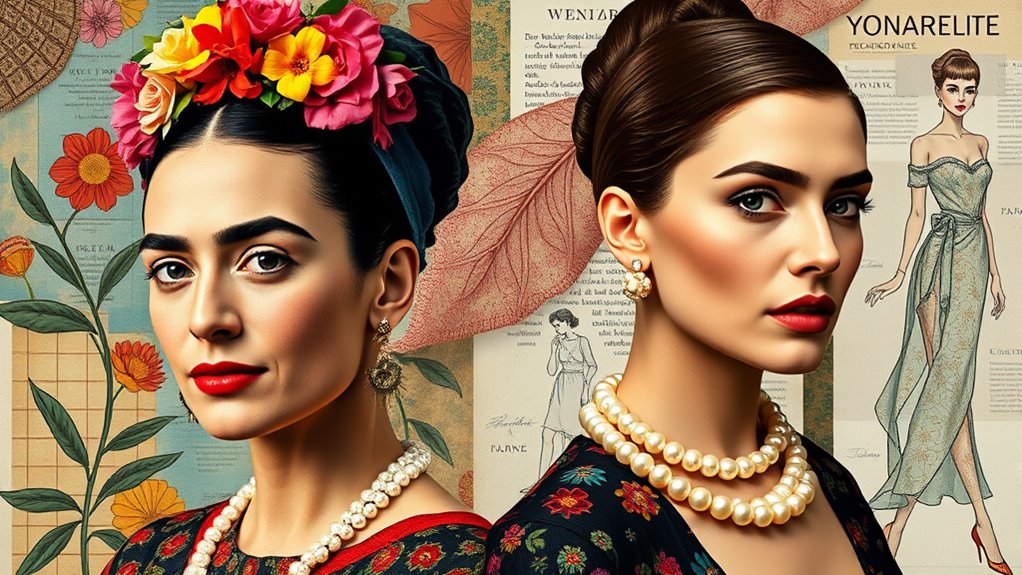
You can see how heritage-inspired collections draw on the styles of icons like Kahlo and Hepburn to promote sustainability and inclusivity. These designs celebrate diverse identities and encourage embracing cultural roots. By doing so, fashion continues to honor the past while shaping a more conscious future. Developing cultural intelligence is essential for designers and brands aiming to authentically integrate cultural elements into their collections. Incorporating traditional craftsmanship can further enrich these designs and support sustainable practices. Embracing global perspectives allows brands to better understand and respect the cultural significance behind traditional styles, fostering authenticity and inclusivity.
Heritage-Inspired Collections
Heritage-inspired collections draw on the rich histories of influential figures like Frida Kahlo and Audrey Hepburn to shape contemporary fashion that’s both sustainable and inclusive. These designs often incorporate traditional textiles and celebrate indigenous craftsmanship, connecting modern styles to cultural roots. By doing so, designers honor historical techniques while promoting ethical practices. Such collections highlight the beauty of handcrafted details and support local artisans, ensuring their skills are preserved. This approach also fosters diversity by elevating overlooked traditions and communities. Additionally, integrating traditional textiles helps preserve cultural identities and promotes sustainable fashion practices. Explore how these collections bridge past and present: [cultural preservation
Embracing Diversity and Identity
Historical figures like Frida Kahlo and Audrey Hepburn continue to inspire modern designers to craft sustainable and inclusive fashion that celebrates diversity and individual identity. They remind you of the importance of cultural representation and identity affirmation in fashion today. To embrace this movement, consider these approaches:
- Incorporate traditional textiles and patterns that highlight cultural roots.
- Design pieces that reflect diverse body types and gender expressions.
- Use eco-friendly materials to promote sustainability alongside inclusivity.
- Highlight stories behind styles to deepen cultural understanding and appreciation.
- Recognize the role of cultural symbolism in shaping meaningful and authentic fashion statements. Additionally, understanding the environmental impacts of fashion choices can inspire more responsible and sustainable practices within the industry.
Frequently Asked Questions
How Do Cultural Icons Influence Global Fashion Trends Today?
You see, cultural icons shape global fashion trends by inspiring designers through cultural symbolism and artistic inspiration. They influence your style choices by popularizing specific motifs, colors, or accessories rooted in their unique backgrounds. When you adopt these elements, you’re connecting with a broader cultural narrative, making your fashion statement more meaningful. This interplay of symbolism and artistic influence keeps fashion dynamic, allowing you to express identity and cultural heritage effortlessly.
In What Ways Do Fashion Designers Incorporate Historical Styles?
Thinking of history like a treasure chest, you see how fashion designers incorporate vintage silhouettes and period costumes into modern designs. They blend old-world charm with contemporary style, creating pieces that feel both nostalgic and fresh. By reinterpreting historical details—like lace, corsets, or bold patterns—they evoke emotion and authenticity, making the past resonate today. This fusion keeps fashion dynamic, reminding you of timeless elegance with a modern twist.
How Do Personal Identity and Cultural Background Shape Iconic Fashion Choices?
You shape iconic fashion choices through personal expression and cultural heritage. Your background influences your style, allowing you to showcase unique traditions, values, and stories. By blending cultural elements with your personality, you create looks that reflect who you are and where you come from. This authenticity makes your fashion choices stand out, inspiring others and highlighting the importance of embracing your identity in every outfit you wear.
What Role Do Social Media Influencers Play in Revitalizing Classic Styles?
You see social media influencers play a big role in revitalizing classic styles through vintage revival and influencer branding. They showcase timeless fashion pieces, blending old and new trends, making them accessible and desirable. By sharing authentic looks and styling tips, influencers inspire you to incorporate vintage elements into your wardrobe, keeping classic styles alive and fresh. Their influence helps you connect with fashion history while expressing your unique personality.
How Are Fashion and Activism Connected Through Cultural Icons?
You see how fashion and activism connect through cultural icons by using political statements and cultural symbolism. Icons like Frida Kahlo and Audrey Hepburn have used their style to challenge norms, promote causes, and express identity. When you wear something inspired by them, you’re not just making a fashion statement but also sharing a message. Their influence encourages you to use style as a powerful tool for activism and cultural expression.
Conclusion
As you weave through the tapestry of fashion’s history, these icons remain your guiding stars, shining brightly amidst a sea of trends. Their styles are like timeless melodies that echo through your wardrobe, inspiring you to craft your unique story. Embrace their boldness, elegance, and authenticity, and let their legacy be the brushstrokes on your personal canvas. In this dance of culture and style, you’re always one striking look away from rewriting the future.

